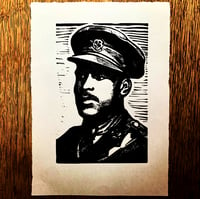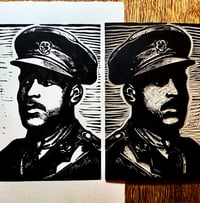Walter Tull (Linocut Print)
*Previously on sale for £30, now £15*
Walter Tull had a challenging childhood, which makes his achievements all the more commendable. He was born in Folkestone, Kent, on 28th April 1888. His father was originally from Barbados (his paternal grandfather was a slave in Barbados) and his mother was born in Kent. But in 1895, when Walter was just 7, his mother died of cancer... and his father then died of heart disease only two years later. It was thus that from the tender age of 9, along with his elder brother, Edward, Walter was placed into a children's home in London’s Bethnal Green.
Two years after entering the home, Walter and Edward were split up when Edward was adopted by the Warnock family of Glasgow, becoming Edward Tull-Warnock. Edward subsequently qualified as a dentist, and was the first mixed-heritage person to practise dentistry in the UK.
In 1909, Walter was signed for Tottenham Hotspurs, and made his first team debut against Manchester United. He was only the third person of mixed heritage to play in the top division of the Football League (after Arthur Wharton and Willie Clarke), and was the victim of atrocious racial abuse, particularly against Bristol City which resulted in, perhaps, the first newspaper headline on the subject in the Football Star: "Football and the Colour Prejudice". He made only 10 first-team appearances for Spurs despite being one of their best players, scoring twice, before he was dropped to the reserves; it’s thought this may have been due to the racial abuse he received.
In October 1911, Walter was transferred to Northampton Town Football Club, where he would go on to play 111 first team games, until the outbreak of World War One brought a premature end to Tull’s promising professional football career. Walter was the first player from his team to enlist in the British Army, initially as a Private in the newly formed 17th ‘Footballers’ Battalion’ of the Middlesex Regiment, which drew professional players from a range of clubs.
Further promotions swiftly followed, and he was soon put forward for a commission. On 29th May 1917 he became the first black officer in the British Army to lead white troops in to battle, and was fondly regarded by the men who served under him. He fought in six major battles of WW1, including the Somme, and was briefly sent home for shell shock before returning to the Italian front line. He is also recorded as having signed for Glasgow Rangers in 1917 (as their first black player), possibly in the period when he’d been sent home with shell-shock; though there’s no evidence that he ever played for them.
Sadly he was killed in action whilst leading his men in a counter attack against German defensive positions on 25th March 1918. He was only 29, and he his body was never recovered although his name is listed with 35k others on the Arras Memorial for soldiers with no known grave. His military leadership received a citation for "gallantry and coolness" and he was put forward for a Military Cross for his extreme bravery, but this was never awarded. Whilst the reason for this decision has never been verified, it could possibly have been because of a military regulation against men of non-European descent becoming officers at that time - so to award him the Military Cross would have drawn attention to this contravention.
There have been campaigns to have this awarded to him posthumously, most notably in 2018 on the centenary of his death, when MP David Lammy said:
"His service on behalf of this country was immense. The records suggest great gallantry, great bravery and a kind of coolness. He saved people's lives, he fought incredibly hard, died young. I think he should be remembered, and the only reason he's not remembered is because at that time there was extraordinary prejudice towards even having a black man in our armed forces, and certainly towards that black man being a second lieutenant and leading other men.”
Although it’s true that he’s a lesser known British hero, he has not been forgotten at Northampton Town FC. A road behind Sixfields Stadium is named Walter Tull Way, and the Walter Tull pub is adjacent to the stadium. On 11th July 1999, a memorial wall to Tull was unveiled in a garden of remembrance at Sixfields Stadium. The text, written by Tull's biographer, Phil Vasili, reads:
“Through his actions, W. D. J. Tull ridiculed the barriers of ignorance that tried to deny people of colour equality with their contemporaries. His life stands testament to a determination to confront those people and those obstacles that sought to diminish him and the world in which he lived. It reveals a man, though rendered breathless in his prime, whose strong heart still beats loudly.”
In September 2018, to mark the centenary of the end of the First World War, Royal Mail produced a set of stamps, one of which featured Tull; and in October 2020, as part of Black History Month, Royal Mail have also painted a postbox black in Glasgow to honour Tull.
You can read more about this remarkable man in this BBC article:
www.bbc.co.uk/sport/football/43504448
ITEM SPECIFICS:
This design is a signed, limited edition of only 50 prints. As with all handmade items, each one will vary slightly, making it completely unique.
It is printed with water-based ink on unbleached, ivory paper that is approximately A5 in size.
The image itself measures roughly 150x100mm. I’ve deliberately made it close in size to my Wilfred Owen print, as I feel they would make a good pair.
Each purchase will include a 10% donation to Kick It Out - a small, independent charity at the heart of the fight against discrimination for everyone who plays, watches or works in football. The ‘Let’s Kick Racism Out of Football’ campaign was established in 1993 in response to widespread calls from clubs, players and fans to tackle racist attitudes existing within the game. Kick It Out was subsequently established in 1997 as it widened out its objectives to cover all aspects of discrimination, inequality and exclusion. You can find out more about the work of the charity on their website: www.kickitout.org.


